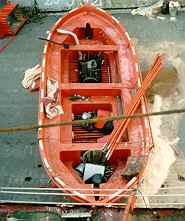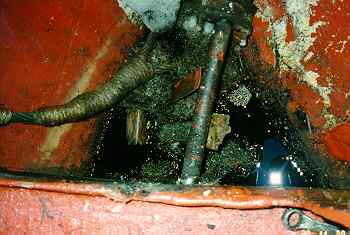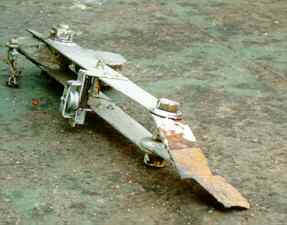Marine transportation safety investigation report M93L0006
Uncontrolled fall of a lifeboat on the general cargo "IRAN SALAM"
Port of Montreal, Quebec
The Transportation Safety Board of Canada (TSB) investigated this occurrence for the purpose of advancing transportation safety. It is not the function of the Board to assign fault or determine civil or criminal liability. This report is not created for use in the context of legal, disciplinary or other proceedings. See Ownership and use of content.
-
Table of contents
Summary
At 1405 on 29 November 1993, a Port State Control Inspection was being carried out aboard the "IRAN SALAM" berthed at Section 50 of the Port of Montreal, Quebec. While the gravity davits of the starboard lifeboat were being tested, the lifeboat fell free on to the wharf. The two crew members who were on board the lifeboat sustained serious injuries and had to be hospitalized.
The Board determined that the lifeboat connections in way of the lifting hook base plates were corroded by rust and failed under the weight of the lifeboat when the gripes were removed. Lack of attention to detail during the inspection for the issuance of a Cargo Ship Safety Equipment Certificate contributed to the accident.
1.0 Factual Information
1.1 Particulars of the Vessel
| "IRAN SALAM" | |
|---|---|
| Official number | 232 |
| Port of registry | Bandar Abbas, Iran |
| Flag | Iranian |
| Type | General cargo |
| Gross TonsFootnote 1 | 9,205 |
| Length | 153 m |
| Draught | FFootnote 2: 4.0 m A: 5.5 m |
| Built | 1975, Viana do Castelo, Portugal |
| Propulsion | Six-cylinder Sulzer diesel engine capable of 5,296 kW, driving a fixed-pitch propeller |
| Owners | Islamic Republic of Iran Shipping Lines, Iran |
1.1.1 Description of the Vessel
The "IRAN SALAM" is a general cargo with the accommodation, bridge and engine-room amidships. On either side of the accommodation, a lifeboat is hung from gravity davits on roller tracks.
This vessel is used mainly for international shipping, and was making her first voyage to Canada.
1.1.2 Description of the Lifeboat
The lifeboat was built in 1975 at the Ustka shipyards in Poland. It is made of reinforced plastic and fitted with an internal combustion engine developing 17.9 kW, and it is 8 m long, 2.85 m wide, and 1.15 m deep. Its loaded weight is 8,585 kg, and it can accommodate up to 56 persons.
The working load of the lowering and hoisting mechanisms at either end of the lifeboat is four metric tonnes.
Each connection at either end of the lifeboat is fitted with a lifting hook and attached to a metal base plate bolted to the keelson. The connections are 7.6 cm wide and 0.9 cm thick in way of the metal base plate. The starboard lifeboat is hung from a gravity davit on roller tracks and is secured in its stowage by gripes at either end. The gripes are made of steel wire rope and are 9.5 mm in diameter. They are fitted with a slip hook for manual release at their lower end and with a shackle at their upper end.
The gripes are adjusted using a turnbuckle, the threaded part of which is secured by a shackle attached to the davit frame, and the other end, the turnbuckle eye, to the gripe shackle. To release the gripes aboard the "IRAN SALAM", crew members must climb aboard the lifeboats and unscrew the turnbuckles until the threaded part disengages.
1.2 Sequence of Events
At about 1405Footnote 3 on 29 November 1993, the "IRAN SALAM" was berthed at Section 50 in the Port of Montreal. Two Canadian Coast Guard (CCG) inspectors boarded the vessel to carry out an inspection under the Port State Control Program, which is designed to ensure compliance with international conventions relating to safety standards aboard vessels. The inspection of the life-saving equipment to be carried out included the testing of the gravity davits. After the port lifeboat was checked, the starboard lifeboat was to be inspected. The master of the "IRAN SALAM" was reluctant to lower the lifeboat as the vessel was berthed starboard side to. However, as he was required to comply with the inspection requirements, the master ordered the starboard lifeboat readied. Two crew members climbed aboard the lifeboat to get it ready for testing.
The gripe adjustment turnbuckles fitted at either end of the lifeboat and used to secure it on the davit had to be removed before the boat could be lowered.
The gripe at the bow of the lifeboat was removed without difficulty, but when the stern gripe turnbuckle was removed, the lifeboat fell free from a height of 7.6 m.
The lifeboat crashed on to the wharf, taking one of the two crew members with it; the other crew member fell 3.7 m and landed on the vessel's boat deck. The two crew members were seriously injured and were given first-aid treatment. One had to be given artificial respiration and a cardiac massage before the two injured crew members were transported to a local hospital by ambulance.
1.3 Injuries to Persons
Only the two crew members who were aboard the starboard lifeboat were injured as a result of this occurrence, and they had to be hospitalized.
1.4 Damage
1.4.1 Damage to the Vessel
The vessel was not damaged.
1.4.2 Damage to the Lifeboat
The starboard lifeboat sustained considerable damage when it crashed on to the wharf. The propeller and propeller shaft were bent in the impact, pieces of fibreglass broke off in some places, and the grab rails along the outside of the hull failed. The lifeboat was repaired and put back in service before the "IRAN SALAM" departed.
1.4.3 Inspection of the Lifeboat Connections by the TSB Engineering Laboratory
The TSB Engineering Laboratory carried out a photogrammetric examination to determine the condition of the lifting hook connections.
The lifting hook connections on the starboard lifeboat were in an advanced state of corrosion, especially the connection of the after lifting hook which had deteriorated further than the forward connection.
Analysis of the connection metal plates indicated that, in way of the point of failure, the two plates comprising the after connection were 1.03 mm and 1.12 mm thick, respectively, and those comprising the forward connection were 1.48 mm and 1.84 mm thick, respectively. These metal plates are normally 0.952 cm thick. The failure of the forward and after connections occurred 7.62 cm from the lifting hook base plate. In addition, discoloration was observed on the inside surface of the lifeboat, indicating an accumulation of water in the bilges, which could have contributed to the corrosion at the base of the connections.
1.5 Certification
1.5.1 Vessel
As a prerequisite for the issuance of a Cargo Ship Safety Equipment Certificate to the "IRAN SALAM", an inspection of the vessel's safety equipment was carried out on 22 October 1992 in compliance with the requirements of the International Convention for the Safety of Life at Sea, 1974 (SOLAS). At that time, several shortcomings, deficiencies and defects were noted which affected safety, including the section relating to the inspection of lifeboats (item G.11 of the Lloyd's survey checklist), which requires that all sheaves, blocks, falls, lifting hooks, hook foundations and securing arrangements, and all moving parts be found free and well lubricated or made good at the time of survey.
A total of four inspections were carried out while the vessel was in different ports in October 1992, December 1992, February 1993 and March 1993. The certificate issued in October 1992 mentions shortcomings related to parts on the port and starboard lifeboats, including the fall blocks and limit switches, but there is no mention of the connections of the starboard lifeboat.
During a second inspection by the same inspector, in December 1992, it was found that the previously noted shortcomings as per the checklist had been corrected and were satisfactory, except for the limit switches.
However, as other items on the checklist were still outstanding, a short-term certificate was issued for a period of one month so that they could be corrected.
In May 1993, a Cargo Ship Safety Equipment Certificate was issued in London, United Kingdom, for the "IRAN SALAM" with an expiry date of 21 October 1994.
At the time of the accident, the "IRAN SALAM" therefore held a valid Cargo Ship Safety Equipment Certificate.
1.5.2 Lifeboat
The certificate for the starboard lifeboat had been issued on 28 January 1975 at Ustka, Poland, in accordance with the SOLAS Convention.
1.5.3 Personnel
The master and all officers held the certificates appropriate for the class of vessel on which they were serving and the voyage being undertaken.
1.6 Weather Information
At the time of the accident, the weather was clear, the air temperature was 1C and the winds were light. Weather is not considered to have played a role in this accident.
1.7 Radio Communications
A few minutes after the accident, a crew member reported the accident to the Vessel Traffic Centre (VTC) at Montreal by radiotelephone and requested that an ambulance be sent to the site. An ambulance was dispatched by the Marine Rescue Sub-centre (MRSC) at Québec. The two injured crew members were transferred to a local hospital.
2.0 Analysis
2.1 Introduction
It is essential that moving parts in service that can constitute a safety hazard for users be kept in good working condition, inspected on a regular basis, and properly maintained.
2.2 Lifeboat Inspection
Chapter I, Part B, Regulation 8(a) of the SOLAS Convention requires that surveys of life-saving appliances and other equipment on cargo ships be conducted every 24 months. These inspections are to be carried out by government officials of the country of registry or by designated inspectors or organizations recognized by that country.
In October 1992, as the inspection for the issuance of a Cargo Ship Safety Equipment Certificate required that the lifeboats be tested, the Lloyd's representative indicated on his checklist (at item G.1) that the two lifeboats had been lowered to the level of the boat deck. The Lloyd's representative nonetheless indicated on the same checklist (at item G.11) that he considered that the forward and after fall blocks on the two lifeboats, which are integral parts of the launching appliances, needed to be replaced because of their corroded condition. However, he did not note any defect of the connections on the starboard lifeboat.
It was determined that the forward connection was as much as 88 to 89 per cent deteriorated, and the after connection was deteriorated as much as 90 to 94 per cent. Such a considerable deterioration only could have developed over a period of several years. In addition, a post-occurrence examination of the connections revealed that the fractures were not fresh over their full width.
In view of the foregoing and of the fact that the Port State Control Inspection at Montreal revealed some 54 regulation violations or safety deficiencies, there is some doubt that there was sufficient attention to detail in the classification society survey. The Port State Control Inspection led to a detention order being issued against the "IRAN SALAM".
As the shortcomings were not referenced in the annex to the short-term certificate issued to the vessel in October 1992, and only the fall blocks and limit switches were mentioned, this seems to indicate that all sheaves, blocks, lifting hooks, hook foundations and securing arrangements, and all moving parts had been inspected and found in good condition. However, subsequent events indicate otherwise.
Sometimes, a different marine surveyor may have to do the follow-up on shortcomings noted in the annex to a certificate. When this happens, if the shortcomings are not cross-referenced with specific items on the checklist, the surveyor doing the follow-up might check only those items noted on the short-term certificate, thereby inadvertently compromising safety.
A commissioned officer on the vessel inspected the lifeboats on a monthly basis. The findings of these inspections were recorded on a ship's checklist. The checklist does not indicate the condition of the lifting hooks or the connections between the lifting hooks and their metal base plates attached to the keelson. The connections were not visible, but they could be accessed through trap doors in chests located at either end of the starboard lifeboat. There is some doubt that there was sufficient attention to detail during the inspections carried out by the vessel's officers.
The ship's log indicates that the starboard lifeboat was launched during a drill on 21 October 1993. The entry reads: "At 1000 hrs. stb. lifeboat prepared and lowered to water level. All moving parts checked and greased; also limit switches tested and found in good working condition."
2.3 Analysis of the Connections
An analysis of the connections of the lifting hooks by the TSB Engineering Laboratory could not determine with accuracy the maximum weight that the connections could support at the time of the accident.
However, the analysis of the sequence of events confirms that the after lifting hook connection was capable of supporting only a light load because of its advanced state of corrosion, which greatly exceeded safety standards.
2.4 Lifeboat Gripes
The method used to rig the lifeboat gripes on the "IRAN SALAM" was incorrect for this type of installation. It is common practice to fit turnbuckles to the lower ends of the gripes so that they can be released from the boat deck without boarding the lifeboat.
The turnbuckles of the lifeboats on the "IRAN SALAM" were at the upper ends of the gripes; therefore, crew members had to climb aboard the lifeboat to release them.
However, there are no rules requiring that the turnbuckles be fitted to the lower ends of the gripes rather than to the upper ends.
2.5 Conduct of the Inspection
CCG Ship Safety Branch inspectors were carrying out a Port State Control Inspection aboard the "IRAN SALAM".
As lifeboat launching appliances are included in the safety equipment control program, they were tested. After the port lifeboat was tested, the inspector in charge requested that the starboard lifeboat be released from its stowage, and the lifeboat crashed on to the wharf.
Subsequently, CCG inspectors decided to carry out a full survey of the vessel, and they noted some 54 shortcomings on the "IRAN SALAM".
3.0 Findings
- A Cargo Ship Safety Equipment Certificate was issued to the "IRAN SALAM" by the Lloyd's classification society in London, United Kingdom, in May 1993, six months before the accident.
- A Port State Control Inspection carried out on 18 December 1993 in Montreal revealed some 54 shortcomings relating to safety equipment aboard the "IRAN SALAM".
- Crew members had to board the lifeboat in order to release the securing gripes.
- The connections in way of the lifting hook base plates at the forward and after ends of the lifeboat were in an advanced state of corrosion.
- The connections could be accessed through trap doors in chests located at either end of the lifeboat.
- An examination of the connections carried out by the TSB Engineering Laboratory revealed that the fractures were not fresh over their full width.
- An accumulation of water in the bilges could have contributed to the corrosion of the metal parts.
- The two crew members who had boarded the starboard lifeboat had to undergo major surgery and they were hospitalized for several weeks.
3.1 Causes and contributing factors
The lifeboat connections in way of the lifting hook base plates were corroded by rust and failed under the weight of the lifeboat when the gripes were removed. Lack of attention to detail during the inspection for the issuance of a Cargo Ship Safety Equipment Certificate contributed to the accident.
4.0 Safety Action
4.1 Safety Action Taken
4.1.1 Inspections
Deficiencies noted on the vessel during the Port State Control Inspection were corrected before the vessel departed Canadian waters.
Following this occurrence, the classification society (Lloyd's Register of Shipping) issued an internal policy calling for increased attention, during lifeboat inspections by its surveyors, to the moving parts of lifeboat launching gears, such as lifting hooks and base plates.
This report concludes the Transportation Safety Board's investigation into this occurrence. Consequently, the Board, consisting of Chairperson John W. Stants, and members Zita Brunet and Maurice Harquail, authorized the release of this report on .
Appendices
Appendix A - Photographs
Appendix B - Glossary
- A
- aft
- C
- Celsius
- CCG
- Canadian Coast Guard
- cm
- centimetre(s)
- EST
- eastern standard time
- F
- forward
- IMO
- International Maritime Organization
- kg
- kilogram(s)
- kW
- kilowatt(s)
- m
- metre(s)
- mm
- millimetre(s)
- MRSC
- Marine Rescue Sub-centre
- SI
- International System (of units)
- SOLAS Convention
- International Convention for the Safety of Life at Sea, 1974
- TSB
- Transportation Safety Board of Canada
- UTC
- Coordinated Universal Time
- VTC
- Vessel Traffic Centre
- °
- degree(s)













